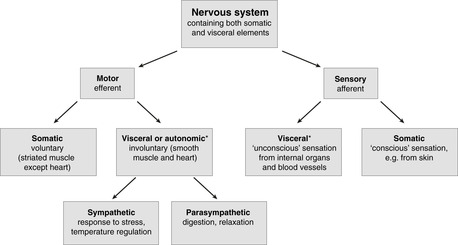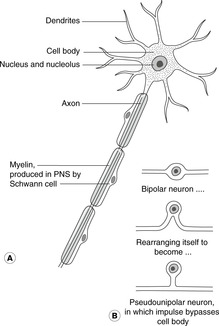Parts and definitions31
6.1. Parts and definitions
Geographical: central/peripheral
Direction of nerve impulse: sensory or afferent/motor or efferent
Nature of perception: somatic sensory/visceral sensory
Type of action: voluntary motor/visceral (involuntary) motor
Autonomic (visceral) nervous system
6.2. Cells of the nervous system, synapse
Neuron (Fig. 6.2)
Synapse
Supporting cells: glial cells, Schwann cells
6.3. Brain and spinal cord
Brain
Cranial nerves
Spinal cord
![]()
Stay updated, free articles. Join our Telegram channel

Full access? Get Clinical Tree



The nervous system
6.2 Cells of the nervous system, synapse33
6.3 Brain and spinal cord33
6.4 Spinal nerves35
6.5 Segmentation, dermatomes, myotomes36
6.6 Autonomic nervous system37
6.7 Spinal cord in the vertebral canal and spinal meninges39
The brain and spinal cord constitute the central nervous system, cranial and spinal nerves the peripheral nervous system. Different descriptive terms are based on direction of impulse (sensory, motor), and nature of sensation or action (somatic, visceral; voluntary, involuntary). Cells of the nervous system are neurons and supporting cells (glial cells, Schwann cells). The central nervous system contains both nerve cell bodies (grey matter) and tracts of axons (white matter), disposed in the spinal cord according to function. Spinal nerves are attached to the spinal cord in such a way that a pair of nerves and the portion of cord to which they are attached constitute a segment. The autonomic (visceral) nervous system controls homeostasis and bodily functions of internal organs, visceral motor impulses forming the sympathetic and parasympathetic nervous systems. Within the vertebral canal the spinal cord is surrounded by spinal meninges. The cord is much shorter than the canal itself, so roots of spinal nerves originating from the low spinal cord must pass within the vertebral canal before they reach the intervertebral foramen through which they pass to the rest of the body.
You should:
• explain the terms central, peripheral, sensory, motor, somatic, visceral, voluntary, involuntary, and describe the relationships between them
• describe the basic organisation of the autonomic nervous system
• list the names and functions of different types of neurons and glial cells
• describe the basic organisation of the brain, spinal cord and spinal nerves
• describe the related concepts of segmentation, dermatomes and myotomes
• describe how the spinal cord is surrounded by spinal meninges, and the anatomy of lumbar puncture.
The nervous system consists of the brain, spinal cord and peripheral nerves. It is one of the means by which central control of bodily functions is maintained, and allows the body to respond to stimuli of various sorts. There are several ways of classifying the components of the nervous system (Fig. 6.1).
• Central nervous system. This is the brain and spinal cord.
• Peripheral nervous system. This is everything else, i.e.:
– cranial nerves arising from the brain: 12 pairs
– spinal nerves arising from the spinal cord: 31 pairs (usually).
A nerve impulse in a peripheral nerve may travel:
• towards the central nervous system: a sensory or afferent impulse; or
• away from the central nervous system: a motor or efferent impulse.
• Somatic sensory impulses are those of which we are acutely aware, and which we are well able to localise (e.g. sharp pain, touch). These generally originate in body wall structures (rather than internal organs). These fibres may run in either cranial or spinal nerves.
• Visceral sensory impulses are either imperceptible, only vaguely localisable, or only become perceptible in disease. They arise from blood vessels or internal organs (viscera), may run in either cranial or spinal nerves and are also found in a network of nerves associated with the internal organs.
Voluntary motor impulses. These control skeletal muscle over which we have voluntary control. From various parts of the brain, nerve impulses pass down in the spinal cord to connect with neurons whose axons pass out of the central nervous system into peripheral nerves.
• The neuron or neurons entirely within the central nervous system are upper motor neurons.
• The neurons with cell bodies in the central nervous system, but whose axons pass into the peripheral nerves, are lower motor neurons. They are found in both cranial and spinal nerves.
Visceral (involuntary) motor or autonomic. These impulses control muscle over which we do not normally have voluntary control. These fibres may run in either cranial or spinal nerves, and are considered in more detail below and in section 6.6.
The visceral components of the nervous system, visceral sensory and visceral motor, supply internal organs and blood vessels. They may be grouped together as the autonomic nervous system, although it is not an anatomically distinct entity. Some components are central, some peripheral: some are in cranial nerves, some in spinal nerves, and some in autonomic plexuses (networks) in and around internal organs.
I recommend that you use the term autonomic to include only visceral motor fibres: use the term visceral sensory for afferent impulses from internal organs and blood vessels.
Neurons are nerve cells. They consist of cytoplasm and a nucleus. The long cytoplasmic process that transmits impulses away from the cell body is the axon. The process that transmits impulses towards the cell body is the dendrite.
• Multipolar neurons. These are found throughout the central nervous system. Motor neurons in the spinal cord are multipolar (have more than one cytoplasmic process), one of the poles being the axon (Fig. 6.2A).
• Bipolar neurons. Peripheral sensory neurons are originally bipolar with one cytoplasmic process which conducts the nerve impulse from the receptor towards the cell body, and one which conducts the impulse from there to the central nervous system. For spinal nerves, and some cranial nerves, the bipolar cell rearranges its processes during development (Fig. 6.2B) to become pseudounipolar, presumably in the interests of speed of conduction (the impulse does not have to ‘wade’ through the cytoplasm of the cell body). The sensory neurons which remain truly bipolar are those of olfaction (smell), vision, hearing and balance where the receptors are close to the brain.
The cell bodies of sensory neurons in a peripheral nerve are all collected together in one site, a ganglion (swelling). In a spinal nerve the sensory ganglion is attached to the dorsal (posterior) root of the nerve (see below), and so is known as the dorsal (posterior) root ganglion; it is found in the region of the intervertebral foramen through which the nerve passes out of the vertebral canal. For a cranial nerve it is simply known as the sensory ganglion of that nerve, and is often given another name peculiar to itself.
Neural pathways involve a chain of separate neurons. Junctional zones are called synapses: here the impulse at the end of one neuron stimulates the neuron to release chemicals (neurotransmitters) that cause electrical impulses to be generated in the succeeding neuron. Synapses are thus relay stations in the neural pathway.
Supporting cells provide structural support and myelin. In the brain these are glial cells: oligodendrocytes for myelin production, astrocytes for structural support. In the spinal cord myelin is produced by Schwann cells. Glial cells give rise to the commonest brain tumours – gliomas.
The brain consists of:
• The brain stem: the central, midline portion made up of (from bottom up) medulla oblongata, pons and midbrain. It is continuous below with the spinal cord and above with the forebrain.
• The cerebellum, behind the pons.
• The forebrain: thalamic structures and right and left cerebral hemispheres.
There are 12 pairs of cranial nerves arising from the brain. They are usually designated by Roman numerals (I–XII), as in this text, and are concerned mainly with structures in the head and neck.
The cranial nerves and brain are considered in more detail in Chapters 14 and 15.
The spinal cord is found within the vertebral (spinal) canal. It has a number of functions.
• It serves as a coordinating centre for each spinal cord segment, e.g. spinal reflexes.
• It receives sensory information from peripheral nerves and sends it on to the brain and to other places for the purposes of perception and for eliciting appropriate responses.

